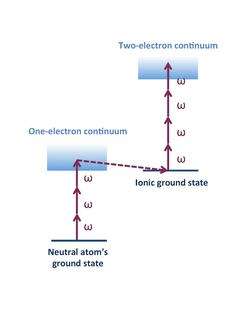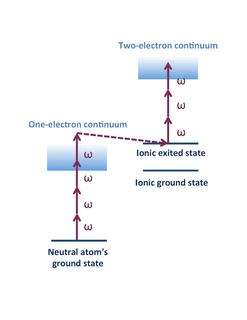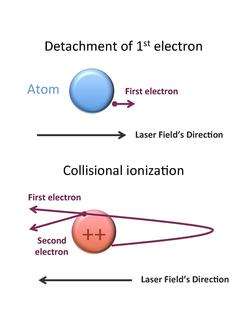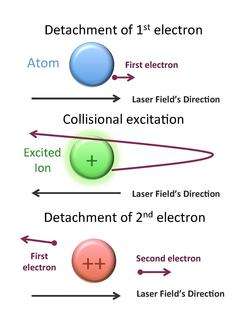Double ionization
Double ionization is a process of formation of doubly charged ions when laser radiation is exerted on neutral atoms or molecules. Double ionization is usually less probable than single-electron ionization. Two types of double ionization are distinguished: sequential and non-sequential.
Sequential double ionization
Sequential double ionization is a process of formation of doubly charged ions consisting of two single-electron ionization events: the first electron is removed from a neutral atom/molecule (leaving a singly charged ion in the ground state or an excited state) followed by detachment of the second electron from the ion.[1]
| Examples of sequential double ionization | ||||
|---|---|---|---|---|
|
Non-sequential double ionization
Non-sequential double ionization is a process whose mechanism differs (in any detail) from the sequential one. For example, both the electrons leave the system simultaneously (as in alkaline earth atoms, see below), the second electron's liberation is assisted by the first electron (as in noble gas atoms, see below), etc.
The phenomenon of non-sequential double ionization was experimentally discovered by Suran and Zapesochny for alkaline earth atoms as early as 1975.[2] Despite extensive studies, the details of double ionization in alkaline earth atoms remain unknown. It is supposed that double ionization in this case is realized by transitions of both the electrons through the spectrum of autoionizing atomic states, located between the first and second ionization potentials.[3] [4] [5] [6] [7] [8]
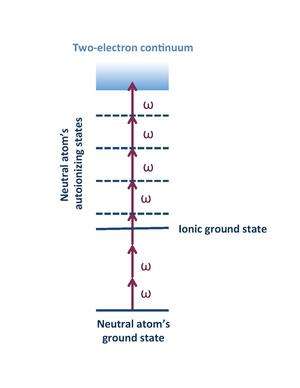
For noble gas atoms, non-sequential double ionization was first observed by L'Huillier.[9][10] The interest to this phenomenon grew rapidly after it was rediscovered[11][12] in infrared fields and for higher intensities. Multiple ionization has also been observed.[13][14] The mechanism of non-sequential double ionization in noble gas atoms differs from the one in alkaline earth atoms. For noble gas atoms in infrared laser fields, following one-electron ionization, the liberated electron can recollide with the parent ion.[15][16] This electron acts as an "atomic antenna",[16] absorbing the energy from the laser field between ionization and recollision and depositing it into the parent ion. Inelastic scattering on the parent ion results in further collisional excitation and/or ionization. This mechanism is known as the three-step model of non-sequential double ionization, which is also closely related to the three step model of high harmonic generation.
Dynamics of double ionization within the three-step model strongly depends on the laser field intensity. The maximum energy (in atomic units) gained by the recolliding electron from the laser field is ,[15] where is the ponderomotive energy, is the laser field strength, and is the laser frequency. Even when is far below ionization potential experiments have observed correlated ionization.[13][14][17][18][19] As opposed to the high- regime ()[20][21][22][23] in the low- regime () the assistance of the laser field during the recollision is vital.
Classical and quantum analysis[24][25][26] of the low- regime demonstrates the following two ways of electron ejection after the recollision: First, the two electrons can be freed with little time delay compared to the quarter-cycle of the driving laser field. Second, the time delay between the ejection of the first and the second electron is of the order of the quarter-cycle of the driving field. In these two cases, the electrons appear in different quadrants of the correlated spectrum. If following the recollision, the electrons are ejected nearly simultaneously, their parallel momenta have equal signs, and both electrons are driven by the laser field in the same direction toward the detector [27] . If after the recollision, the electrons are ejected with a substantial delay (quarter-cycle or more), they end up going in the opposite directions. These two types of dynamics produce distinctly different correlated spectra (compare experimental results [13][14][17][18][19] with .[22][23]
| Non-sequential double ionization of noble gas atoms | ||||
|---|---|---|---|---|
|
See also
- List of laser articles
- Nonlinear optics
- Photoionization
- Ionization
- High harmonic generation
- Above threshold ionization
![]() Physics portal
Physics portal
![]() Science portal
Science portal
References
- ↑ Delone, N. B.; Krainov, V. P. (2000). Multiphoton Processes in Atoms. Springer. ISBN 3540646159., chapter 8.
- ↑ Suran, V. V.; Zapesochny, I. P. (1975). "Observation of Sr2+ in multiple-photon ionization of strontium". Sov. Tech. Phys. Lett. 1 (11): 420.
- ↑ Lambropoulos, P.; Tang, X.; Agostini, P.; Petite, G.; L'Huillier, A. (1988). "Multiphoton spectroscopy of doubly excited, bound, and autoionizing states of strontium". Physical Review A. 38 (12): 6165–6179. Bibcode:1988PhRvA..38.6165L. doi:10.1103/PhysRevA.38.6165. PMID 9900374.
- ↑ Bondar', I. I.; Suran, V. V. (1993). "The two-electron mechanism of Ba2+ ion formation in the ionization of Ba atoms by YAG-laser radiation". JETP. 76: 381. Bibcode:1993JETP...76..381B.
- ↑ Bondar’, I. I.; Suran, V. V. (1998). "Resonance structure of doubly-charged-ion production during laser dielectronic ionization of atoms". Journal of Experimental and Theoretical Physics Letters. 68 (11): 837. Bibcode:1998JETPL..68..837B. doi:10.1134/1.567802.
- ↑ Bondar, I. I.; Suran, V. V.; Dudich, M. I. (2000). "Resonant structure in doubly charged ion formation during multiphoton ionization of Sr and Ba atoms by infrared laser radiation". Journal of Physics B: Atomic, Molecular and Optical Physics. 33 (20): 4243. Bibcode:2000JPhB...33.4243B. doi:10.1088/0953-4075/33/20/304.
- ↑ Liontos, I.; Bolovinos, A.; Cohen, S.; Lyras, A. (2004). "Single and double ionization of magnesium via four-photon excitation of the 3p^{2}^{1}S_{0} autoionizing state: Experimental and theoretical analysis". Physical Review A. 70 (3). Bibcode:2004PhRvA..70c3403L. doi:10.1103/PhysRevA.70.033403.
- ↑ Liontos, I.; Cohen, S.; Lyras, A. (2010). "Multiphoton Ca2+production occurring before the onset of Ca+saturation: Is it a fingerprint of direct double ionization?". Journal of Physics B: Atomic, Molecular and Optical Physics. 43 (9): 095602. Bibcode:2010JPhB...43i5602L. doi:10.1088/0953-4075/43/9/095602.
- ↑ l'Huillier, A.; Lompre, L.; Mainfray, G.; Manus, C. (1982). "Multiply Charged Ions Formed by Multiphoton Absorption Processes in the Continuum". Physical Review Letters. 48 (26): 1814. Bibcode:1982PhRvL..48.1814L. doi:10.1103/PhysRevLett.48.1814.
- ↑ l'Huillier, A.; Lompre, L. A.; Mainfray, G.; Manus, C. (1983). "Multiply charged ions induced by multiphoton absorption in rare gases at 0.53 μm". Physical Review A. 27 (5): 2503. Bibcode:1983PhRvA..27.2503L. doi:10.1103/PhysRevA.27.2503.
- ↑ Walker, B.; Mevel, E.; Yang, B.; Breger, P.; Chambaret, J.; Antonetti, A.; Dimauro, L.; Agostini, P. (1993). "Double ionization in the perturbative and tunneling regimes". Physical Review A. 48 (2): R894–R897. Bibcode:1993PhRvA..48..894W. doi:10.1103/PhysRevA.48.R894. PMID 9909791.
- ↑ Walker, B.; Sheehy, B.; Dimauro, L.; Agostini, P.; Schafer, K.; Kulander, K. (1994). "Precision Measurement of Strong Field Double Ionization of Helium". Physical Review Letters. 73 (9): 1227–1230. Bibcode:1994PhRvL..73.1227W. doi:10.1103/PhysRevLett.73.1227. PMID 10057657.
- 1 2 3 Rudenko, A.; Zrost, K.; Feuerstein, B.; De Jesus, V.; Schröter, C.; Moshammer, R.; Ullrich, J. (2004). "Correlated Multielectron Dynamics in Ultrafast Laser Pulse Interactions with Atoms". Physical Review Letters. 93 (25). arXiv:physics/0408065
 . Bibcode:2004PhRvL..93y3001R. doi:10.1103/PhysRevLett.93.253001.
. Bibcode:2004PhRvL..93y3001R. doi:10.1103/PhysRevLett.93.253001.
- 1 2 3 Zrost, K.; Rudenko, A.; Ergler, T.; Feuerstein, B.; Jesus, V. L. B. D.; Schröter, C. D.; Moshammer, R.; Ullrich, J. (2006). "Multiple ionization of Ne and Ar by intense 25 fs laser pulses: Few-electron dynamics studied with ion momentum spectroscopy". Journal of Physics B: Atomic, Molecular and Optical Physics. 39 (13): S371. Bibcode:2006JPhB...39S.371Z. doi:10.1088/0953-4075/39/13/S10.
- 1 2 Corkum, P. (1993). "Plasma perspective on strong field multiphoton ionization". Physical Review Letters. 71 (13): 1994–1997. Bibcode:1993PhRvL..71.1994C. doi:10.1103/PhysRevLett.71.1994. PMID 10054556.
- 1 2 Kuchiev, M. Y. (1987). "Atomic Antenna". JETP Letters. 45: 404. Bibcode:1987JETPL..45..404K.
- 1 2 Zeidler, D.; Staudte, A.; Bardon, A. B.; Villeneuve, D. M.; Dörner, R.; Corkum, P. B. (2005). "Controlling Attosecond Double Ionization Dynamics via Molecular Alignment". Physical Review Letters. 95 (20). Bibcode:2005PhRvL..95t3003Z. doi:10.1103/PhysRevLett.95.203003.
- 1 2 Weckenbrock, M.; Zeidler, D.; Staudte, A.; Weber, T.; Schöffler, M.; Meckel, M.; Kammer, S.; Smolarski, M.; Jagutzki, O.; Bhardwaj, V.; Rayner, D.; Villeneuve, D.; Corkum, P.; Dörner, R. (2004). "Fully Differential Rates for Femtosecond Multiphoton Double Ionization of Neon". Physical Review Letters. 92 (21). Bibcode:2004PhRvL..92u3002W. doi:10.1103/PhysRevLett.92.213002.
- 1 2 Liu, Y.; Tschuch, S.; Rudenko, A.; Dürr, M.; Siegel, M.; Morgner, U.; Moshammer, R.; Ullrich, J. (2008). "Strong-Field Double Ionization of Ar below the Recollision Threshold". Physical Review Letters. 101 (5). Bibcode:2008PhRvL.101e3001L. doi:10.1103/PhysRevLett.101.053001.
- ↑ Yudin, G.; Ivanov, M. (2001). "Physics of correlated double ionization of atoms in intense laser fields: Quasistatic tunneling limit". Physical Review A. 63 (3). Bibcode:2001PhRvA..63c3404Y. doi:10.1103/PhysRevA.63.033404.
- ↑ Becker, A.; Faisal, F. H. M. (2005). "Intense-field many-bodyS-matrix theory". Journal of Physics B: Atomic, Molecular and Optical Physics. 38 (3): R1. Bibcode:2005JPhB...38R...1B. doi:10.1088/0953-4075/38/3/R01.
- 1 2 Staudte, A.; Ruiz, C.; Schöffler, M.; Schössler, S.; Zeidler, D.; Weber, T.; Meckel, M.; Villeneuve, D.; Corkum, P.; Becker, A.; Dörner, R. (2007). "Binary and Recoil Collisions in Strong Field Double Ionization of Helium". Physical Review Letters. 99 (26). Bibcode:2007PhRvL..99z3002S. doi:10.1103/PhysRevLett.99.263002.
- 1 2 Rudenko, A.; De Jesus, V.; Ergler, T.; Zrost, K.; Feuerstein, B.; Schröter, C.; Moshammer, R.; Ullrich, J. (2007). "Correlated Two-Electron Momentum Spectra for Strong-Field Nonsequential Double Ionization of He at 800 nm". Physical Review Letters. 99 (26). Bibcode:2007PhRvL..99z3003R. doi:10.1103/PhysRevLett.99.263003.
- ↑ Haan, S.; Breen, L.; Karim, A.; Eberly, J. (2006). "Variable Time Lag and Backward Ejection in Full-Dimensional Analysis of Strong-Field Double Ionization". Physical Review Letters. 97 (10). Bibcode:2006PhRvL..97j3008H. doi:10.1103/PhysRevLett.97.103008.
- ↑ Ho, P.; Eberly, J. (2006). "In-Plane Theory of Nonsequential Triple Ionization". Physical Review Letters. 97 (8). arXiv:physics/0605026
 . Bibcode:2006PhRvL..97h3001H. doi:10.1103/PhysRevLett.97.083001.
. Bibcode:2006PhRvL..97h3001H. doi:10.1103/PhysRevLett.97.083001.
- ↑ Figueira De Morisson Faria, C.; Liu, X.; Becker, W. (2006). "Classical aspects of laser-induced non-sequential double ionization above and below the threshold". Journal of Modern Optics. 53: 193. Bibcode:2006JMOp...53..193F. doi:10.1080/09500340500227869.
- ↑ Bondar, D.; Liu, W. K.; Ivanov, M. (2009). "Two-electron ionization in strong laser fields below intensity threshold: Signatures of attosecond timing in correlated spectra". Physical Review A. 79 (2). arXiv:0809.2630
 . Bibcode:2009PhRvA..79b3417B. doi:10.1103/PhysRevA.79.023417.
. Bibcode:2009PhRvA..79b3417B. doi:10.1103/PhysRevA.79.023417.
